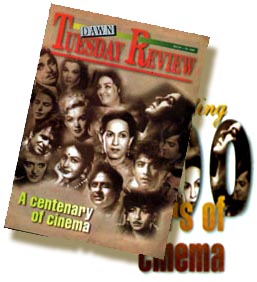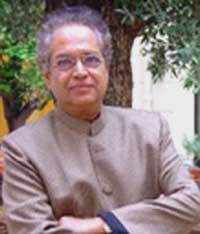 Cinerama
Cinerama
DAWN Tuesday Review, October
24-30, 1995
The Rise and Fall of Cult Heroes
In the span of its history, the Indo-Pakistani
cinema has seen the rise of such screen figures as K.L.Segal,
Dilip Kumar, Waheed Murad and Amitabh Bachan. The popularity of
Dilip Kumar and Amitabh Bachan has remained evident on both sides
of the border. The range of enthusiastic fans is one evidence.
Another is the number of clones they have spawned.
To mention a few imitators of Dilip
Kumar in Pakistan: Santosh Kumar, Nadeem and Hanif. The foremost
imitator of Amitabh Bachan was Izhar Qazi. Waheed Murad had the
disadvantage of a cinema that sought to cover a limited market.
In spite of this the neighbouring country could not remain blind
to his charms and he had an ardent imitator in the superstar Jeetendra.
Indeed the cult heroes have been setting the trends for films
in their own times in both the countries. The question is, why
do some screen figures rise so high above their peers? How do
they succeed in capturing the fancy of their audience to such
a degree that the audience is not just willing to crown the heroes
with laurels but is also ready to accept anyone who imitates them?
Film critics agree that there is more than just the quality of
acting involved in the making of a cult figure.
Various theories have been forwarded
to explain the phenomena. I will here discuss only two of them
because I think these two explain each other.
 The
first theory is propounded by Sudhir Kakar, an eminent Indian
psychoanalyst, in his book The
Intimate Relations. Kakar draws attention to the psycho-social
roots of the audience themselves. He mentions three prototypes
in the South Asian culture. The first is Lord Krishna. In mythology
he is presented as a naughty youth who would hide away the clothes
of young gopis while they take a bath in the river. This
prototype appears in the Indian cinema in characters usually played
by Dev Anand and Shammi Kapoor in the 50s and the 60s. In a typical
Shammi Kapoor film, for instance, the heroine first appears as
an extrovert character confronting the hero without many hang
ups, as she is unaware of her own sexuality. In the course of
their conflict the hero not only asserts the proof of his own
manhood but also arouses the sexuality of the young virgin who
subsequently sinks into modesty. The psycho-social theory of cult
figures shows this pattern as inherent in the stories of the land,
and therefore appealing to the Indian psyche.
The
first theory is propounded by Sudhir Kakar, an eminent Indian
psychoanalyst, in his book The
Intimate Relations. Kakar draws attention to the psycho-social
roots of the audience themselves. He mentions three prototypes
in the South Asian culture. The first is Lord Krishna. In mythology
he is presented as a naughty youth who would hide away the clothes
of young gopis while they take a bath in the river. This
prototype appears in the Indian cinema in characters usually played
by Dev Anand and Shammi Kapoor in the 50s and the 60s. In a typical
Shammi Kapoor film, for instance, the heroine first appears as
an extrovert character confronting the hero without many hang
ups, as she is unaware of her own sexuality. In the course of
their conflict the hero not only asserts the proof of his own
manhood but also arouses the sexuality of the young virgin who
subsequently sinks into modesty. The psycho-social theory of cult
figures shows this pattern as inherent in the stories of the land,
and therefore appealing to the Indian psyche.
A divergence from this prototype
is the introvert lover epitomised for the cine-goers of the 50s
by Dilip Kumar in Devdas and Guru Dutt in Piyasa.
Indeed we can add the name of Waheed Murad in this list.
This is a character who leaves the action of the world to look
inside. Unrequitted or lost love is the cause of his anguish.
The prototype of this figure can be found in the legendary hero
of the age-old tale of Laila Majnun. The story originated in Arabia,
and reached the Indo-Pakistan through Persian sources. Certainly
it has taken roots here as a popular folk tale (Incidentally both
India and Pakistan have filmed it. One of the Pakistani versions
featured Waheed Murad as Majnun.)
The third type of hero appeared
in the screen image of Amitabh Bachan. To him, amorous love is
secondary as compared to his armed struggle against the decadent
order of the society, and he doesn't always find himself on the
right side of the law. A prototype of this figure might be found
in the classical Hindu legend of Mahabharata. There we
have Karna, who was deserted by his mother soon after his birth.
As a grown up he goes to the battlefield of Mahabharata, to raise
arms against his own brothers. As his mother approaches him to
stop, he lets her down, saying that she did not support him when
he needed her most, how could she expect him to obey her now?
Of course, the deprived childhood of Karna, his warlike disposition
and his final reply all remind us of the best of Amitabh Bachan
films, such as Deevar (1975), and Shakti 1982).
According to the psycho-sociological
theory, all these prototypes remain alive in the collective unconscious
of the people and thereby instigate them to approve of such screen
figures who come to represent any of these. Also, it must be noted
that a cultural prototype can find a rise in a particular period
and then face a decline but never completely die away. Hence,
while we have the Karna-type Amitabh in Sholay (1976)
taking the front seat. There still is the Krishna-type Dharmendra
in the tandem. And so we see that the prototype has remained there
only the emphasis has changed with time. Here lies the rub. Is
there something beyond the collective unconscious of the people
that dictates what prototype should receive emphasis at a given
period in the history of a people?
The second theory which I wish to
discuss in this article, is an answer to this question. It states
that the social or political conditions of a people may dictate
their preference for a particular cult hero. The exponents of
this theory have picked up as particular examples, three cult
figures from the Indo-Pakistani cinema: Dilip Kumar, Waheed Murad
and Maitabh Bachan.
Dilip Kumar rose to unparalleled
heights of popularity soon after independence, in a society that
was ready to welcome change but also wanted to retain something
of the old order. Through melodramatic films like Aan (1952),
(and even Devdas, to an extent), Dilip represented the
spirit of change and liberty along with the right degree of sadism
and snobbery that was the legacy of the feudal social order. (His
portrayal of Devdas seems passive and mellow, but he still appears
far more high-handed than the 1935 version of K.L. Saigal).
Likewise, the rise of Waheed Murad
in the Pakistan society can be seen in the perspective of military
dictatorship within the country and a general trend of permissiveness
that marked the 60s all over the world. The younger generation
in Pakistan, brought up under a non-political and pseudo-democratic
order of life was all set to turn away its attention in other
directions that the economic and political issue of the society.
It was therefore prepared to find abode in the unreal but pleasant
pastures of fantasy. The release of Arman (1966) was the grand
explosion of Waheed Murad syndrome clearing the ground for films
that could take escapism to its most delightful heights.
The most successful of Waheed Murad
films, such as Arman, Andaleeb (1969), Anjuman (1970), etc.,
bypass the economic issue as they place the hero in a stable position
in society. A natural debanaire, Waheed was ideally suited for
such roles. At the slightest sign of trouble he would throw himself
away into fits of melancholy and bouts of alcoholism -- the ultimate
dream of an escapist! While the hero thus lies dormant, licking
his wounds, it remains for the female staff to clear up the mess.
Not surprisingly, some of the strongest female characters of our
cinema appear in such films as Arman and Andaleeb.
Little need to be said about the
socio-political background of the 70's and the 80's, which witnessed
the rise of Amitabh Bachan as incarnation of the Karna prototype.
The shortcoming of law and the weakness of those responsible to
enforce it had become more evident than ever before. Also, there
was an increased awareness that the expectations people had made
about independence had not come true even after nearly three decades
later. And yet those expectations had not been given up entirely.
This tension worked up a frustration that could find expression
in the person of Amitabh Bachan.
It comes out from any careful study
that the cult figures of the Indo-Pakistani cinema have roots
in cultural patterns of society. Various social and political
conditions dictate the shift of people's emphasis from one prototype
(and the cinematic hero representing it) to another. This may
partially explain why the regional films still hold attraction
to the people in spite of all their shortcomings and even in the
face of the Urdu-Hindi versions of the technologically superior
foreign films.

